|
|
| |
Music
of Swiss monasteries with trumpet marine |
|
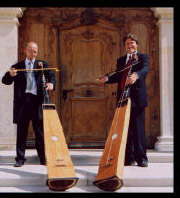 |
This project of the ensemble arcimboldo was dedicated to an
instrument many people heard about, but they did not really
hear it: the trumpet marine. On this site you can find an
article about the history
of the trumpet marine by Dr. Silke Berdux (conservator of
music instruments, German museum, Munich), all informations
about the concert-program: "Music of Swiss
monasteries
with trumpet marines" and an article about the whole project and the performance practice by Thilo Hirsch.
A
CD recording of this outstanding project is available on the Label musiques
suisses. |
|
|
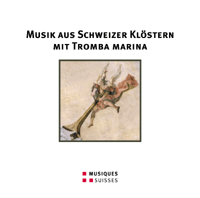
MGB CD 6224
sound
examples |
|
|
| "A
trumpet strung with a single string"
Tromba
marina, trumscheit, trumpet violin, Mary's trumpet or nun's violin
are different names of the instrument that is placed centre-stage
on this project of the ensemble arcimboldo. Above
all, it is the last of these names that has guaranteed the
instrument a certain fame down to the present day, even if as
usual this represents but a part of the historical truth. Even
more than its appearance, it is the instrument's sound that makes
it so peculiar. Although it is a string instrument, it sounds like
a trumpet. The reason for this is its asymmetrical, shoe-shaped
bridge. It is attached to the body of the instrument only at the
short end, while the other hangs freely above it. When the string
is made to vibrate, the longer end hits the body and thus creates
the trumpet-like brassy sound. |
|
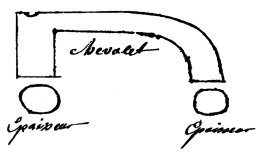
|
|
Tromba
marina-bridge after J.B. Prin, 1742 |
|
However,
it is not just the sound quality of the instrument, but its range of
notes that corresponds to the trumpet. For it is played only in
harmonics, i.e. the string is not pressed down upon the fingerboard,
but only touched at the points where harmonics occur. This activates
the notes of the natural scale, which correspond to those of the
trumpet.
The tromba marina was in use from the first half of the 17th century
until into the 19th. In central Europe, it was widely used and not at
all as rare as we assume today. This is proven by the fact that more than 200 instruments have survived, and numerous sources that testify
to its use. In France, which boasts the only tromba marina virtuoso
known to us by name one Jean- Baptiste Prin (16691743), the
instrument was played at court. In Italy, it was used especially in
operas with a maritime theme. It is to be found in the secular
repertory in German-speaking countries too. Thus the "Music
Society" in Zurich printed trombae marinae several times on the
title pages of its New Year's pieces in around 1700; and in 1792, Johann
Rudolph 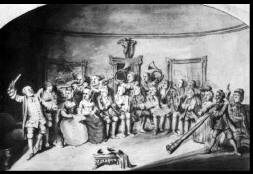 Wettstein drew a picture of a Basle music society including a tromba marina. The
instrument is also occasionally found in the inventories of court
music ensembles, as for example in Cöthen in 1733. In Switzerland,
southern Germany, the Tyrol and Slovakia, the instrument was played
mostly in monasteries and churches. There does not seem to be a
connection with any particular monastic order, nor was it used
exclusively by nuns as the name "nun's violin" might suggest. The
tromba marina is known to have been used in both convents and
monasteries. In Switzerland, its use is proven through entries in
financial records in the monasteries of St Anna in Bruch, St Katharina
in Eschenbach and St Urban (Canton Lucerne), St Klara in Stans (Canton
Nidwalden), St Carl in Altdorf (Canton Uri), Einsiedeln (Schwyz),
Wettingen (Aargau), Maria Zuflucht in Weesen (Canton St Gall),
Wonnenstein (Canton Appenzell) and elsewhere. One instrument has
survived in both St Andreas in Sarnen (Canton Obwalden) and St Lazarus
in Seedorf (Canton Uri), while eight exist in St Katharinenthal in
Diessenhofen (Canton Thurgau). In the monastery of Engelberg (Canton
Obwalden), several compositions for the instrument by Wolfgang Iten
have survived. Wettstein drew a picture of a Basle music society including a tromba marina. The
instrument is also occasionally found in the inventories of court
music ensembles, as for example in Cöthen in 1733. In Switzerland,
southern Germany, the Tyrol and Slovakia, the instrument was played
mostly in monasteries and churches. There does not seem to be a
connection with any particular monastic order, nor was it used
exclusively by nuns as the name "nun's violin" might suggest. The
tromba marina is known to have been used in both convents and
monasteries. In Switzerland, its use is proven through entries in
financial records in the monasteries of St Anna in Bruch, St Katharina
in Eschenbach and St Urban (Canton Lucerne), St Klara in Stans (Canton
Nidwalden), St Carl in Altdorf (Canton Uri), Einsiedeln (Schwyz),
Wettingen (Aargau), Maria Zuflucht in Weesen (Canton St Gall),
Wonnenstein (Canton Appenzell) and elsewhere. One instrument has
survived in both St Andreas in Sarnen (Canton Obwalden) and St Lazarus
in Seedorf (Canton Uri), while eight exist in St Katharinenthal in
Diessenhofen (Canton Thurgau). In the monastery of Engelberg (Canton
Obwalden), several compositions for the instrument by Wolfgang Iten
have survived.
The tromba marina was used for the instrumental accompaniment of vocal
music, and for pieces for instruments alone. In the chronicle of the
Dominican Convent of St Katharina in Augsburg, it is written, for
example, that in 1697, "6 trombae marinae and timpani [played]
together with the organ in the Prince's procession", and that a
"Sonata with 4 trombae marinae and timpani" was performed.
We also know that in the Seligenthal Monastery in Landshut, the
instrument was used to play in processional
music.
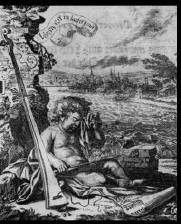 A
number of pieces have survived that explicitly mention the use of the tromba marina. Alternative instruments are also often mentioned. Thus,
for example, on the Pastorella by Wolfgang Iten, the words "Violini,
vel etiam Tubae Marinae"are written. It therefore seems clear that the tromba marina often
played trumpet or violin parts when these could be realized on it.
Only in very few cases will this have been marked on the parts
themselves, so the exact number will remain unknown. Towards the end
of the 18th century, the tromba marina gradually disappeared from
music life, though it was occasionally played as late as the middle of
the 19th century. E. T. A. Hoffmann paid homage to it in his Life and
Opinions of the Tomcat Murr, making it the instrument of Tante Füsschen.
The instrument enjoyed a renaissance at the end of the 19th century.
In the private instrument collections that began to be gathered
together at the time, the tromba marina was one of those instruments
that had to be included (though its history was confused with that of
its predecessor, the trumscheit). It was at this time that the name
"nun's violin" was coined posthumously, so to speak, and
presumably out of the desire to create a "history" for the
instrument. A
number of pieces have survived that explicitly mention the use of the tromba marina. Alternative instruments are also often mentioned. Thus,
for example, on the Pastorella by Wolfgang Iten, the words "Violini,
vel etiam Tubae Marinae"are written. It therefore seems clear that the tromba marina often
played trumpet or violin parts when these could be realized on it.
Only in very few cases will this have been marked on the parts
themselves, so the exact number will remain unknown. Towards the end
of the 18th century, the tromba marina gradually disappeared from
music life, though it was occasionally played as late as the middle of
the 19th century. E. T. A. Hoffmann paid homage to it in his Life and
Opinions of the Tomcat Murr, making it the instrument of Tante Füsschen.
The instrument enjoyed a renaissance at the end of the 19th century.
In the private instrument collections that began to be gathered
together at the time, the tromba marina was one of those instruments
that had to be included (though its history was confused with that of
its predecessor, the trumscheit). It was at this time that the name
"nun's violin" was coined posthumously, so to speak, and
presumably out of the desire to create a "history" for the
instrument.
Dr
Silke Berdux
Conservator of Music Instruments
German Museum, Munich
|
| |
| Program: |
|
Johann
Friedrich Korb
(about
1750) |
- |
Offertorium
"Gaude Felix", Canto, Alto, Tenore, Basso, 2
Violinis, 2 Clar. ex D, con Organo
Moderato un poco allegro
(Monastery
St
Katharinental) |
|
|
|
Wolfgang
Iten
(1712-1769) |
- |
"Inter
choros angelorum" a Canto solo con 2 Violini, Tromba
marina obligata e Organo
Recitativo - Aria
(Monastery
Engelberg) |
|
|
|
Anonymus
(about
1741) |
- |
"Consideravi
te", Aria für Tenor, Violoncello solo, 2 Violinen und Orgel
Recitativo - Aria/Allegro - Rec. -
Aria - Rec. - Aria
(Monastery
St Lazarus Seedorf) |
|
|
|
Michael
Bürgin
(*1969) |
- |
Cantata
"Journey to Ettingen" for four voices, strings,
Bassoon, 2 Trumpet marines and Organ
(Première) |
|
|
|
Marianus_Königsperger
(1708-1769) |
- |
Concerto
ex G a Organo Principali, 2 Violini, Viola et Violoncello
Moderato - Adagio - Allegro
(Monastery St Katharinental) |
|
|
|
Franz
Niklaus Jakob
(1719-91) |
- |
Salve
Regina a 4 Vocibus, 2 Violinis, 2 Tromb., Violoncello et
Organo Andante - Allegretto - Adagio
- Spiritoso
(Monastery
St Andreas Sarnen) |
|
|
|
Wolfgang
Iten
(1712-1769) |
- |
"Pastorella"
a Canto, Alto, 2 Trompetta Maria e
Organo Recitativo - Aria/Largo
(Monastery
Engelberg) |
|
|
|
Nescio
(um
1790) |
- |
"Ein
Mischmasch oder Cassatio" a
Violino, Viola e Basso con Trompetchen, Gugu und Rätschchen
Marche/Adagio -
Allegro - Trio - Menuetto - Trio -Finale/Allegro - Trio
(Monastery
St Andreas Sarnen) |
|
|
|
Wolfgang
Iten
(1712-1769) |
- |
"Majestas
Domini" Offertorium Solemne a quattro Voci, 2
Violinis, 2 Clarini con Organo e Bassetto Allegro - Allegro - Aria/Duetto - Allegro
(Monastery
Engelberg) |
|
|
Sara
Bilén - soprano
Monika Barmettler - alto
Hans-Jürg Rickenbacher - tenor
Raitis Grigalis - bass
Thilo
Hirsch - trumpet marine
Michael Bürgin - trumpet marine
Christoph
Rudolf - violin
Matthieu Camillieri - violin/viola
Felix Knecht - cello
Elisabeth Kaufhold - bassoon
Diana Fazzini - violone
Angelika Hirsch - organ
Philip Tarr - timpani |
| |
The
trumpet marine - One of the last adventures in early music
How
does one actually come to play the trumpet marine? In the last
three years, I have often been asked this, and would therefore
like to sketch out the story of my own journey to this
admittedly somewhat odd instrument.
In museums, my attention was often drawn by this strange,
elongated, more than two metre-long string instrument, of which
no one quite knew how it sounded. In 2001, the new premises in
Lohnhof of Basle's Music Instrument Museum were opened. No less
than seven original trumpet marines were there, and one could
for the first time hear an example of how they used to sound. I
was fascinated. After I had worked my way into the material
there is a wealth of literature on it it became clear to me
that the trumpet marine must have been a perfectly "normal"
instrument in the 17th and 18th centuries. Its being spread
widely across the whole Alpine region, the fact that the royal
court ensemble of France had its own section called crumhorns
and marine trumpets from 1661 to 1762 (thus for more than
100 years) all this seemed to confirm my assumption. When the
original instrument of the trumpet marine virtuoso Jean-Baptiste
Prin (16691743) finally surfaced in a private Swiss collection
two years ago, after having been thought lost since 1900, my
ideas took on concrete form. I wanted to reconstruct this
instrument, and to learn to play it. Thus began one of the "last adventures" of early music. |
| |
|
|
trumpet
marine by Inber, Lyon, ca. 1715 |
|
After I had found an interested violin maker in the person of Jürg
Buchwalder of Basle, who also had a delight in experimentation,
we had numerous constructional problems to solve. In November
2002, the first of the two instruments was finished, and I could
begin fitting it out and practising it. The principal matter was
making a good buzzing bridge (the problems of making and
installing one are documented often in the historical sources).
After carving and trying out numerous bridges, I succeeded in
producing all the notes evenly (from the 3rd to the 16th
overtone) and with a trumpet-like sound. While learning to play the
trumpet marine from the historical
sources above all J. B. Prin's "Reminiscences of the trumpet
marine" from 1742 I was also searching for pieces
from Swiss monasteries of which it was proven that they featured
the trumpet marine, or which had been composed for it (see the article by S. Berdux above).
 The fruits of this fascinating musical treasure hunt in Baroque
monastery libraries can be divided into three groups: The first
comprises larger-scale ensemble works with two trumpet marines,
such as the Salve Regina by Franz Niklaus Jakob from St Andreas
in Sarnen, the offertory Majestas Domini by Wolfgang Iten from
the Engelberg Monastery, and the Gaude Felix by Johann Friedrich
Korb that was written for the monastery of St Katherinental. The
trumpet marines here have the same function as "normal"
trumpets and are usually denoted in the parts as clarino or tromba. It seems to have been usual to have trumpet
marines play these parts; even the trumpet marine-playing cherub
on the Zurich New Year's Piece of 1699 is reading from a part
marked clarino. The second group comprises works in which the trumpet marine is
used as a solo instrument, as for example in Iten's Inter choros
angelorum or his Pastorella, which is a duet with another trumpet
marine. What is interesting about the latter piece is the change
of name to Trompetta Maria. A tromba maria is
naturally far better suited to a monastery than is a tromba
marina, which brings sailors to mind rather than the Virgin
Mary. The third group comprises the "special" pieces that I
discovered while on my search. One of these is the Mish-mash or
cassation for violino, viola and basso with little trumpet, gugu
and Rätschchen by Nescio (from the Latin nescire: "not to
know"). Presumably, someone did not want to call the
composer "anonymous", and so gave their "not
knowing" as his name. The instruments "little trumpet, gugu and Rätschchen" in
the title were probably the same "Berchtesgaden children's
instruments" as are used in the "Kindersinfonie"
by Johann Nepomuk Angerer (17401794), previously ascribed to
Joseph Haydn. These "special" pieces also include the
anonymous arias with obligato cello from St Lazarus in Seedorf
and the organ concerto by Marianus Königsperger from the
Katharinental Monastery. The fruits of this fascinating musical treasure hunt in Baroque
monastery libraries can be divided into three groups: The first
comprises larger-scale ensemble works with two trumpet marines,
such as the Salve Regina by Franz Niklaus Jakob from St Andreas
in Sarnen, the offertory Majestas Domini by Wolfgang Iten from
the Engelberg Monastery, and the Gaude Felix by Johann Friedrich
Korb that was written for the monastery of St Katherinental. The
trumpet marines here have the same function as "normal"
trumpets and are usually denoted in the parts as clarino or tromba. It seems to have been usual to have trumpet
marines play these parts; even the trumpet marine-playing cherub
on the Zurich New Year's Piece of 1699 is reading from a part
marked clarino. The second group comprises works in which the trumpet marine is
used as a solo instrument, as for example in Iten's Inter choros
angelorum or his Pastorella, which is a duet with another trumpet
marine. What is interesting about the latter piece is the change
of name to Trompetta Maria. A tromba maria is
naturally far better suited to a monastery than is a tromba
marina, which brings sailors to mind rather than the Virgin
Mary. The third group comprises the "special" pieces that I
discovered while on my search. One of these is the Mish-mash or
cassation for violino, viola and basso with little trumpet, gugu
and Rätschchen by Nescio (from the Latin nescire: "not to
know"). Presumably, someone did not want to call the
composer "anonymous", and so gave their "not
knowing" as his name. The instruments "little trumpet, gugu and Rätschchen" in
the title were probably the same "Berchtesgaden children's
instruments" as are used in the "Kindersinfonie"
by Johann Nepomuk Angerer (17401794), previously ascribed to
Joseph Haydn. These "special" pieces also include the
anonymous arias with obligato cello from St Lazarus in Seedorf
and the organ concerto by Marianus Königsperger from the
Katharinental Monastery.
In order to expand the radius of the trumpet marine's repertoire
into the 21st century, the ensemble arcimboldo commissioned a
work from Michael Bürgin (*1969). After a performance in the
German Museum in Munich, a criticwrote the following about Bürgin's
piece, entitled Journey to Ettingen: "With the Journey
to Ettingen we experienced an unexpectedly chromatic turn of
the screw. Amongst these historical Swiss sacred gems, Michael Bürgin
has smuggled a cantata enriched by jazzy bass riffs, unusual
pizzicato effects and Orffian force."
Remarks on performance practice
Besides
the search for the sonic possibilities of the trumpet marine, one
of the most basic questions regarding the playing of the
instrument was whether, and to what extent, one can and should
correct the "impure" overtones in its natural scale.
We here mean above all the 11th overtone, namely the "alphorn
fourth" that lies more or less exactly between f² and
f#² (when starting on C), and also the 13th overtone, a very
low a².
In the 18th century, this phenomenon of the "impure"
overtones was an everyday matter, since before the invention of
valves, all the brass instruments without a slide had to deal
with it (the length of the vibrating column of air could not be
altered, except in the case of the trombone and the slide
trumpet). One could protest, however, that today's Baroque
ensembles also use natural trumpets, and that they have no
problem with intonation. However, upon closer inspection, one
realizes that these so-called natural trumpets are played with
up to four finger holes a practice for which there is no
historical proof, neither in the numerous old trumpet tutors,
nor in the surviving old instruments. This is in fact an
invention of the 20th century!
In the meantime, there are ensembles that play with "real"
natural trumpets, and have to deal intensively with the problem
of the natural overtone scale. The trumpeters and horn players
attempt to correct the natural overtones by pursing their lips.
The trumpet marine has the possibility of correcting the 11th and
13th overtones by gently pressing the thumb against the string (unless the composer expressly asks for the "impure"
note, as in Bürgin's Journey to Ettingen). However, the
"buzzing" quality is then reduced, and the tone colour
is altered considerably. One can hear this particularly well in
the Pastorella by Iten. This effect can best be compared with
the "stopped" notes of the natural horn (a technique
that was used by horn players from the mid-18th century onwards
in order to correct the overtones). There, too, the tone colour
of individual notes varies greatly
between "open" and "stopped" notes.
For the present CD recording, we naturally would have had the
possibility to "improve" the natural overtones of the
trumpet marine through the use of recording tricks. But it seemed
more important to us that the instruments should sound as
authentic as possible, even if this meant occasional, minor
uneven passages.
We are delighted to be able to present on this CD the results of
a quite special musical "adventure", and we invite you
to discover, together with the ensemble arcimboldo, an unknown,
forgotten world of sound.
Thilo
Hirsch |
| |
Sponsors:
Instruments:
-
Kanton Thurgau, Lotteriefonds
- Kanton Schwyz, Kulturförderung
- Alfred Richterich Stiftung
- Private Sponsoren
Concerts:
-
Kanton Basel Landschaft (Musikkredit)
- Kanton Thurgau, Lotteriefonds
- Kanton Obwalden, Kulturförderung
- Sophie und Karl Binding Stiftung
- Stiftung der Schw. Landesausstellung
1939
- Emil Richterich-Beck Stiftung
- Familien-Vontobel-Stiftung
- Ernst Göhner Stiftung, Zug
- Migros-Kulturprozent
- Stiftung zur Förderung der darb. Künste
- Turgauische Kulturstiftung Ottoberg
- Sarna Jubiläums-Stiftung
|
|
|
|
|



